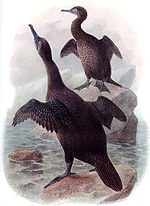John Gerrard Keulemans
John Gerrard Keulemans (born June 8, 1842 in Rotterdam , Netherlands as Johannes Gerardus Keulemans , † March 29, 1912 in Ilford , United Kingdom ) was a Dutch painter and illustrator . Keulemans was famous for his bird lithographs .
Life

Keulemans was an enthusiastic nature lover even as a boy and wanted to become a researcher. Hermann Schlegel , the then director of the Reich Museum for Natural History in Leiden , supported him and sent him on a business trip to West Africa in 1864 . When he returned to Europe in 1866, Schlegel recommended him to the British Museum . In 1867 he married Engelina Johanna Spoor in Voorschoten , who often supported him in his work. From 1869 Keulemans worked in Great Britain, where he regularly illustrated the bird journal Ibis of the British Ornithologists' Union and the journal Proceedings and Transactions of the Zoological Society of London . His studies of the nectar birds in West Africa enabled him, together with other talented draftsmen, to illustrate the work Monograph of the Nectarinidae (1876) by George Ernest Shelley (1840–1910). After the death of his first wife in 1876, he married Arabella Miley, an Irish woman, in London in 1877. A total of 14 children resulted from his marriages.
From 1874 to 1898 he worked on the 27 volumes of the Catalog of the Birds of the Natural History Museum (then British Museum of Natural History). As a distinguished illustrator, he created 73 plates for the work Monograph of Hornbills (1887–1892) by Daniel Giraud Elliot (1835–1915), 120 plates for Monograph on Kingfishers (1868–1871) by Richard Bowdler Sharpe (1847–1909) and 149 Plates for Monograph on Thrushes (1902) for Henry Seebohm (1832–1895). Other works illustrated by Keulemans are various volumes of Biologia Centrali-Americana (1879–1904) by Osbert Salvin (1835–1898), Birds of Europe (1871–1896) by Henry Eeles Dresser (1838–1915), A History of the Birds of New Zealand (1873, 1887–1888, 1905–1906) by Sir Walter Buller (1838–1906), The Avifauna of Laysan and the Neighboring Islands (1893–1900) by Lionel Walter Rothschild, 2nd Baron Rothschild (1868–1937 ) and Extinct Birds (1907) by Lionel Walter Rothschild. The work A History of the Birds of New Zealand initially appeared in an edition of 500 copies. The 35 lithographic plates were hand-colored by Keulemans. Due to its great success, a second, expanded edition was published, which contains more details about synonyms and distribution as well as the description of new species. Since the lithographic stones for the first edition had been destroyed, they were all redrawn by Keulemans. The second edition appeared in thirteen parts between July 1887 and December 1888. Although 1000 copies of the second edition were made, 251 copies were lost in the sinking of two ships. In 1906 a two-volume supplement was published with an edition of 500 copies.
Keulemans made remarkable lithographs on by now-extinct animal species, including the Salomon dove , the Huia , the great auk , the Stephens Island Wren , the Hawai'i'Ō'ō , the Bishop's'Ō'ō , the Guadalupe Storm Petrel , the Weißwangenkauz and the Falkland Islands Wolf . All of these lithographs are now in the American Museum of Natural History in New York .
gallery
Gallery with lithographs by John Gerrard Keulemans (some extinct species):
Stephenschlüpfer
from Walter Buller : A History of the Birds of New Zealand, 1888Ear tuft moho
from Walter Rothschild : The Avifauna of Laysan,
1893–1900Magnificent moho
from Walter Rothschild: The Avifauna of Laysan,
1893–1900
Huia
from Walter Buller: A History of the Birds of New Zealand, 1888Barnacle owl
from George Dawson Rowley : Ornithological Miscellany ,
Vol. I, 1875Falkland Islands Wolf
of St. George Mivart : Dogs, Jackals, Wolves, and Foxes ,
1890Soot mamo
from Walter Rothschild: The Avifauna of Laysan,
1893–1900
Web links
- Illustrations from Birds of Laysan
- Keulemans lithographs
- Online exhibition about Keuleman's work
- Family tree of the Keulemans family
- Biography (to be found under the link kunstenaar (az))
- Literature list in the online catalog of the Berlin State Library
| personal data | |
|---|---|
| SURNAME | Keulemans, John Gerrard |
| ALTERNATIVE NAMES | Keulemans, Johannes Gerardus (maiden name) |
| BRIEF DESCRIPTION | Dutch painter and illustrator |
| DATE OF BIRTH | June 8, 1842 |
| PLACE OF BIRTH | Rotterdam , Netherlands |
| DATE OF DEATH | March 29, 1912 |
| Place of death | Ilford , United Kingdom |









